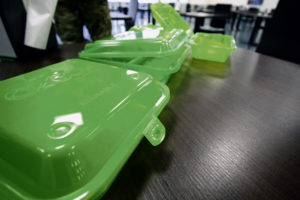
Serving three meals to a hospital with over 2,500 staff members and an average guest throughput of more than 2,500 a day means a lot of waste over the course of a year.
To combat waste production, improve sustainability and contribute to the U.S. Army Installations Strategy, a 15-year long strategy which aims to take care of people, enhance readiness and resilience, modernize and innovate, and promote stewardship, Landstuhl Regional Medical Center’s Dining Facility is slated to move toward 100 percent recycled reusable plastic containers for patrons who aren’t dining in the facility. This effort would replace the current polystyrene foam containers while reducing waste and promoting stewardship in the host nation of Germany.
“We decided to start a sustainability initiative in order to reduce our waste stream and try and be more environmentally friendly,” said U.S. Army Maj. Andrew Otto, chief of Culinary and Hospitality at LRMC. “(The containers) are widely known throughout the (culinary) industry. They are at universities, civilian hospitals and other military dining facilities also have them.”
According to Otto, the containers are a small part of the sustainability solution with the more critical element being a refrigerator-sized food collection system which was recently installed inside the dining facility. The collection system allows patrons to return their reusable containers for a token which can later be redeemed for a clean reusable container, either at the original dining facility or any other participating dining facility, including those outside the military.
“There’s going to be a little bit of a different process of how (a customer) normally would get meals,” explains Otto. “(Participants) would be utilizing this machine with every meal that you get. You purchase the container and take the container wherever you would like to eat your meal, whether it’s here in the dining facility or back at your office, or even take them home and consume the meal there. These containers are more leak proof than the standard (meal to-go) disposable. When you’re done with that meal, you scrape out remaining food, return the container into the machine and repeat the cycle.”
While there are nearly a dozen reusable containers of different capacities, including a 16-ounce cup and cutlery, LRMC will begin with a smaller variety of containers to assess the process. According to the manufacturer, containers are reusable up to 300 times, microwave and freezer safe and can be washed in dishwashers. Additionally, the new containers are BPA-free and also utilized at nearby military installations such as Ramstein and Spangdahlem Air Bases.
“The machine helps reduce our carbon footprint by using reusable containers, helps reduce greenhouse gas emissions and helps reduce water usage, said Otto. “All of our trash with the typical (polystyrene foam) or even (paper-based) disposables have to be processed somehow and right now it goes out through trash.”
According to some studies, the decomposition of polystyrene foam is estimated to take up to 500 years and has recycling options. Additionally, the U.S. Environmental Protection Agency classifies the product as a possible carcinogen, making greener, more sustainable alternatives more inviting.
“We’ve got a few different other sustainability efforts going on such as rewriting our menu to be more seasonal to minimize overall impact and cost,” said Otto. “We’re all in this together and trying to be better stewards for our host nation facilities.”


